Known in his youth as "The Boy Paderewski", Willie Eckstein would never let up from his enormous drive and amazing abilities, becoming Eastern Canada's premier pianist even before the death of fellow musician Jean-Baptiste Lafrenière in 1912. Short only in height, but not in talent, Willie's path was evident before he was even in school. He was the youngest of what was reportedly fourteen children (only nine were confirmed) born to Swedish immigrant George Hugo Eckstein (shows as Eckstine in 1881) and his German wife Wilhelmina Hildebrandt in Pointe St. Charles, a mostly Irish district of Montréal, Quebec, where they were shown in the 1891 census. His musically trained parents had come original from Sweden to New York City, then Hamilton, Ontario, and had moved to Montréal just a year before Willie's birth. Among his siblings were August (1872), George Hugo Jr. (1874), Wilhelmina (Mina) (1876), Henry (1878), Emily (1880 - died in childhood), Augusta Bianca (1882), Clara Henrietta (1883), John Ion Adolphe [or Jack] (1886) who would also enjoy a somewhat successful musical career. William was baptized in early December 1889 along with many of his siblings at the Presbyterian Church of Saint Mathew in Pointe St. Charles.
Willie must have known where his heart was early on, because it is said his first demonstration at the piano was at age three, when he plucked out the melody of Home Sweet Home just after a visitor had played the same piece a day before. Obviously the Ecksteins knew from their own musical passions that they should have the toddler trained to make the best use of his inherent abilities. The earliest lessons may have been given at home, but it was clear that a career teacher was necessary to handle the child prodigy. At some point in the mid-1890s the family moved to the Hochelaga area of Montréal where they were shown in the 1901 census. George is listed as a furrier, George Jr. as a bookkeeper, Mina as a machine operator, Clara worked in a paper box factory, and John, only 15, was already a clerk.
Eventually Willie was put under the tutelage of music teacher Moretzky Upton of McGill University, along with assorted other instructors who taught him piano, theory and harmony. He studied constantly from late 1894 to around 1900. One issue that Eckstein had to overcome was a paralyzed finger, which was either a birth defect or became disabled at a very early age. Another was his diminutive size and therefore slightly smaller hands. As an adult he came in at only 4'10" (reports vary, but that is the average height), shorter even than famed American pianists Eubie Blake and Charles "Luckey" Roberts. It seems in the end that neither problem held him back, and perhaps encouraged him to achieve more.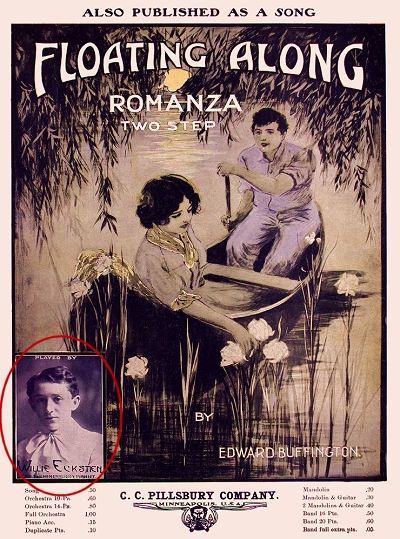 During these years Willie also worked to earn money for his training, dressed up to attract attention while playing at a store near his home. Billed as the "Swedish Boy Wonder," he was employed by the Bell Piano Company as a salesman for two years running at the Canadian National Exhibition.
During these years Willie also worked to earn money for his training, dressed up to attract attention while playing at a store near his home. Billed as the "Swedish Boy Wonder," he was employed by the Bell Piano Company as a salesman for two years running at the Canadian National Exhibition.
 During these years Willie also worked to earn money for his training, dressed up to attract attention while playing at a store near his home. Billed as the "Swedish Boy Wonder," he was employed by the Bell Piano Company as a salesman for two years running at the Canadian National Exhibition.
During these years Willie also worked to earn money for his training, dressed up to attract attention while playing at a store near his home. Billed as the "Swedish Boy Wonder," he was employed by the Bell Piano Company as a salesman for two years running at the Canadian National Exhibition.Around 1900 the boy prodigy was offered a scholarship in music to attend a local conservatory (McGill Conservatory has been cited, but it was likely McGill University as the Conservatory did not open until 1904). He achieved this goal by memorizing 47 pages of Mendelssohn's Concerto in D Minor. But the money was not enough to address the concerns of his large family and keep him in school. He was heard by someone who was in effect a talent scout while playing in Montréal and offered a job playing in New York City for a time.
It is said he was performing in a storefront in New York when he was heard by yet another agent and quickly offered a $15,000 per year contract on the Keith/Albee, Proctor and Orpheum vaudeville circuits. Hoping to have obtained regular recitals for his living instead, Willie knew how much his family needed the funds, so reluctantly accepted with his father's prompting. Eckstein was billed as the "Boy Paderewski" and was routinely dressed in little boy's clothing, taking advantage of his diminutive height to make him appear much younger than his actual age. The great Paderewski came to see him as well, fully approving of the use of his name in regards to the talents of the amazing youth. Willie toured most of the population centers of the United States and Canada from coast to coast during his vaudeville tenure. While performing in Washington D.C. in 1905, he was offered a performance at the White House for President Theodore Roosevelt. He was often billed over other well-known stars on the same program, including Harry Houdini and the husband and wife team of Nora Bayes and Jack Norworth. Around 1905 (some sources cite 1901, so this is uncertain) Willie traveled to his parent's home country of Sweden, where he spent time there and in Germany receiving musical training while earning money performing, even giving a royal command performance along the way. Eckstein was on his way to the top, or so it seemed.
Nature can't be stopped, and neither could the onset of puberty. Willie's voice deepened and his facial hair growth accelerated to the point where he reportedly needed to shave twice daily in order to maintain the illusion of being a pre-teen. Suspicions grew, and eventually bookings started to diminish as he seemed more adult and less child-like. At the end of one of the tours Eckstein was back in New York City struggling to make ends meet while playing in storefronts and restaurants. So in late 1906 the 18-year-old boy wonder returned to Montréal to find steady work. This he did at the Lyric Music Hall on St. Catherine Street, similar to many of the vaudeville venues he had been through over the last several years.
He spent much of the next six years there, evolving from a theater accompanist for live singers to an accompanist for actors on screen. It was said he was among the first accompanists for a teen-aged Beatrice Lillie who graced the stage there. It was also where he was working when he composed and published his first compositions in 1910, including his first piano rag, Some Rag: A Real Live One. He was shown living in St. Jacques, Montréal, still with his family in the 1911 Canadian census, and listed as a musician.
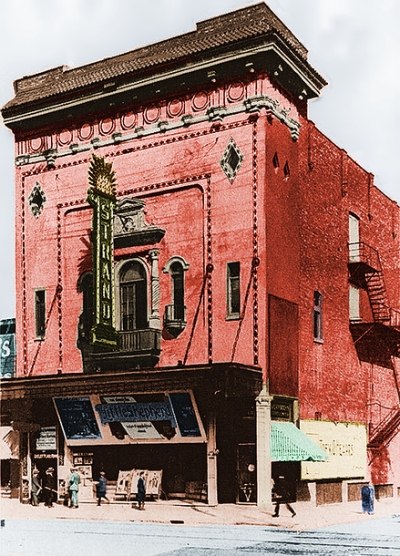 |
By 1910 films started to draw audiences more so than live performers. So progress came to downtown Montréal in 1912 when the 1,000 seat Strand Theater, intended primarily for movie exhibition, was opened by George Ganetakos. Willie was offered a job there even as the theater was under construction and he was still plugging away at the Lyric. From opening day on it was evident that the former child prodigy had a gift for fitting the proper musical settings to otherwise silent films, enhancing not only the story for those in attendance, but the overall ambience of the theater as well. He was also somewhat of a celebrity piano demonstrator for the J.W. Shaw Piano Company.
During his 18 year tenure at the Strand, Willie enjoyed great celebrity not only in Montréal but far outside of it as well. In his compositions and publicity he used many variations on his name, including Billy and Billie, and occasionally Wm. for William, but the theater publicity machine further dubbed "Mr. Fingers," and ultimately "The World's Foremost Motion Picture Interpreter," a claim that was likely very valid. In fact, it has been said that many who attended the Strand, including a bevy of musicians, paid more attention to Eckstein's varied scores for the film than they did to what was on the large screen. Among the notables who expressed amazement at the big sound coming from the little guy were Eubie Blake, Joseph Hoffman, Vladimir de Pachmann, and even the brilliant pianist and composer Sergei Rachmaninoff who reportedly expressed utter amazement at what he was hearing, stating "I don't believe it." For many years he worked with percussionist Armand Meerte, who provided both rhythm and some of the sound effects. One future starlet of note, Miss Norma Shearer, remembered attending matinees instead of high school in order to hear Willie play his own composition Beautiful Thoughts and other favorites. And while the stars of the pictures got their names on the marquee, Eckstein had a two-story wall all to himself with a painting depicting him at his craft.
Willie started putting more of his own works into print after a few years at the Strand, and even took on at least one young protégé during his tenure, someone who could fill in when the maestro wasn't around. He was Reginald Thomas Broughton, a British import, who would soon take on the stage name of Harry Thomas.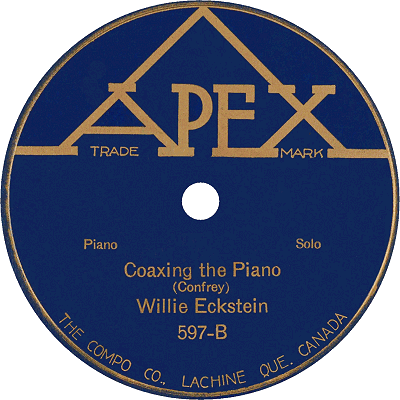 Harry had enough of a foundation as a performer to go to Chicago in 1916 and record two of their as yet unpublished collaborations, Delirious Rag and Perpetual Rag, to piano roll for QRS. He later went to New York City to record Delirious Rag and his own Classical Spasm for Victor, making him the first Canadian musician to record ragtime piano. In spite of their sometimes difficult but fruitful time together, Thomas ended up with little traction in the performance world beyond the mid-1920s, and tragically died from the ravages of alcoholism in 1941. But he did help to spread Willie's name further into the United States. One other young British protégé, Miss Vera Guillarof, would have much more success as his substitute and later as a replacement for Thomas. She would occasionally work with Eckstein on the radio, and in nightclubs in later years.
Harry had enough of a foundation as a performer to go to Chicago in 1916 and record two of their as yet unpublished collaborations, Delirious Rag and Perpetual Rag, to piano roll for QRS. He later went to New York City to record Delirious Rag and his own Classical Spasm for Victor, making him the first Canadian musician to record ragtime piano. In spite of their sometimes difficult but fruitful time together, Thomas ended up with little traction in the performance world beyond the mid-1920s, and tragically died from the ravages of alcoholism in 1941. But he did help to spread Willie's name further into the United States. One other young British protégé, Miss Vera Guillarof, would have much more success as his substitute and later as a replacement for Thomas. She would occasionally work with Eckstein on the radio, and in nightclubs in later years.
 Harry had enough of a foundation as a performer to go to Chicago in 1916 and record two of their as yet unpublished collaborations, Delirious Rag and Perpetual Rag, to piano roll for QRS. He later went to New York City to record Delirious Rag and his own Classical Spasm for Victor, making him the first Canadian musician to record ragtime piano. In spite of their sometimes difficult but fruitful time together, Thomas ended up with little traction in the performance world beyond the mid-1920s, and tragically died from the ravages of alcoholism in 1941. But he did help to spread Willie's name further into the United States. One other young British protégé, Miss Vera Guillarof, would have much more success as his substitute and later as a replacement for Thomas. She would occasionally work with Eckstein on the radio, and in nightclubs in later years.
Harry had enough of a foundation as a performer to go to Chicago in 1916 and record two of their as yet unpublished collaborations, Delirious Rag and Perpetual Rag, to piano roll for QRS. He later went to New York City to record Delirious Rag and his own Classical Spasm for Victor, making him the first Canadian musician to record ragtime piano. In spite of their sometimes difficult but fruitful time together, Thomas ended up with little traction in the performance world beyond the mid-1920s, and tragically died from the ravages of alcoholism in 1941. But he did help to spread Willie's name further into the United States. One other young British protégé, Miss Vera Guillarof, would have much more success as his substitute and later as a replacement for Thomas. She would occasionally work with Eckstein on the radio, and in nightclubs in later years.Eckstein continued to write, often providing lyrics for somebody else's tune, and working as his own lyricist as well. His command of most music forms was impressive, but his ragtime skills were stellar, in part because of the types of music that ragtime was culled from. However, even before the term was coined, Eckstein was adding tricks to his playing which equated to the genre of "Novelty Ragtime," something that would become very much in vogue by the 1920s. But in doing so his improvisation was more or less laid out rather than spur of the moment, which kept him perhaps an arm's length from being a full-fledged jazz musician, even though he would embrace and play jazz well once it made the rounds in Quebec. During the First World War he collaborated on a couple of patriotic numbers. Due to his height he was excluded from serving in the Canadian Armed Forces, even though he did try to enlist. So he fought by playing at rallies to help sell war bonds. In 1919 Eckstein was teamed up for a one-shot song with American composer/artist Gene Buck. Goodbye Sunshine, Hello Moon was featured in the Ziegfeld Follies of that year as well as comedian Ed Wynn's Carnival, providing him with something of a hit. In the end, however, the demand for his tunes on Broadway never panned out. But it was also the same year he was first heard on radio station XWA (later CFCF), accompanying singer Gus Hill and playing some on his own, making him the first Canadian to play ragtime piano over the air, and history records that it was likely the first live broadcast ever in North America.
The next step starting around 1919 was to get Willie's playing archived on recordings. His first forays onto record were as part of the Strand Trio with his brother Jack on the violin and Armand Meerte (or so it seems likely) on the xylophone.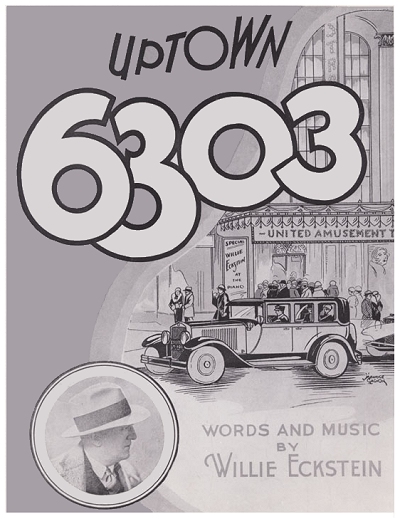 These were released on the Canadian subsidiary of HMV (His Master's Voice) records, the British equivalent of the Victor label. Jack would also start his own jazz band, the first in Montréal, which often featured Willie at the piano both on records and for occasional live performances. Willie also recorded (often as Billy Eckstein) with the Melody Kings, of which another song collaborator, Billy Munro, was a member. They were more of an improvisational "hot jazz" group than Jack's band. Most of the tunes were covers of current popular jazz hits.
These were released on the Canadian subsidiary of HMV (His Master's Voice) records, the British equivalent of the Victor label. Jack would also start his own jazz band, the first in Montréal, which often featured Willie at the piano both on records and for occasional live performances. Willie also recorded (often as Billy Eckstein) with the Melody Kings, of which another song collaborator, Billy Munro, was a member. They were more of an improvisational "hot jazz" group than Jack's band. Most of the tunes were covers of current popular jazz hits.
 These were released on the Canadian subsidiary of HMV (His Master's Voice) records, the British equivalent of the Victor label. Jack would also start his own jazz band, the first in Montréal, which often featured Willie at the piano both on records and for occasional live performances. Willie also recorded (often as Billy Eckstein) with the Melody Kings, of which another song collaborator, Billy Munro, was a member. They were more of an improvisational "hot jazz" group than Jack's band. Most of the tunes were covers of current popular jazz hits.
These were released on the Canadian subsidiary of HMV (His Master's Voice) records, the British equivalent of the Victor label. Jack would also start his own jazz band, the first in Montréal, which often featured Willie at the piano both on records and for occasional live performances. Willie also recorded (often as Billy Eckstein) with the Melody Kings, of which another song collaborator, Billy Munro, was a member. They were more of an improvisational "hot jazz" group than Jack's band. Most of the tunes were covers of current popular jazz hits.In 1923, Herbert Berliner, son of the pioneer phonograph inventor Emile Berliner, started the Compo company in Canada, being one of the first to use the electronic recording process in North America, a clear advantage over the acoustic horn recording that had been common at the time. Willie did his first solo recordings for Compo, choosing Scott Joplin's Maple Leaf Rag for his first cut. While it is not the first known recording of the piece, it is the oldest surviving acoustic recording of the well-known rag. These early records saw good distribution on the Okeh, Apex and Starr labels of Compo in North America. Another notable recording done that same year was his A Musical Massacre, a ragtime take on Frederic Chopin's Revolutionary Etude. It would not be in print until the late 1990s when Canadian pianist Mimi Blais, one of the only other performers of the piece who could fully capture Eckstein's ferocity and whimsy, would supervise its publication. Willie would be very supportive of Berliner over the next several years, sometimes recording as Vi Palmer. He would later also record for the Victor label from around 1929-1932.
But after almost two decades as one of the biggest celebrities in Eastern Canada, Willie Eckstein was upstaged by no less than one of the top celebrities of the United States, Al Jolson. The arrival of The Jazz Singer signaled an obvious end to movies without sound, meaning movies that would no longer need accompaniment. When The Strand finally made the latent conversion in 1930 (most Montréal theaters had already been fitted for sound) there were very few movies coming in that required Eckstein's soundtrack. So he finally left the lucrative position and struck out for new venues.
It didn't take the popular pianist long to find new spots. Given how popular Canada had become over the previous decade for those south of the border who were suffering through a national prohibition, Toronto and Montréal were definitely hotspots for visitors looking for the nightlife and the alcohol that went with it. "Mr. Fingers" found work in The Clover Cafe and the Lido Club. However, once he reached the Château Ste. Rose in Laval, a northern suburb of Montréal, he found his new home.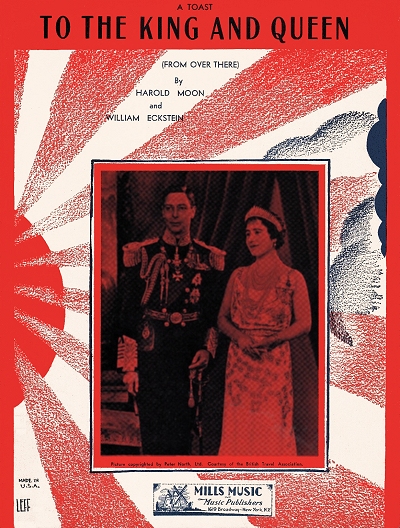 Along with pianist Robert Langlois, who he often played duets with, and Langlois' house orchestra, Willie started a two decade and more stint at the club. He also did regular performance with occasional radio and early television appearances during this time. He often performed broadcasts with Vera Guillarof, billed together as The Piano Ramblers. Willie continued to compose as well, writing To the King and Queen in honor of a 1939 visit from the residents of Buckingham Palace, who in turn sent him letters of appreciation.
Along with pianist Robert Langlois, who he often played duets with, and Langlois' house orchestra, Willie started a two decade and more stint at the club. He also did regular performance with occasional radio and early television appearances during this time. He often performed broadcasts with Vera Guillarof, billed together as The Piano Ramblers. Willie continued to compose as well, writing To the King and Queen in honor of a 1939 visit from the residents of Buckingham Palace, who in turn sent him letters of appreciation.
 Along with pianist Robert Langlois, who he often played duets with, and Langlois' house orchestra, Willie started a two decade and more stint at the club. He also did regular performance with occasional radio and early television appearances during this time. He often performed broadcasts with Vera Guillarof, billed together as The Piano Ramblers. Willie continued to compose as well, writing To the King and Queen in honor of a 1939 visit from the residents of Buckingham Palace, who in turn sent him letters of appreciation.
Along with pianist Robert Langlois, who he often played duets with, and Langlois' house orchestra, Willie started a two decade and more stint at the club. He also did regular performance with occasional radio and early television appearances during this time. He often performed broadcasts with Vera Guillarof, billed together as The Piano Ramblers. Willie continued to compose as well, writing To the King and Queen in honor of a 1939 visit from the residents of Buckingham Palace, who in turn sent him letters of appreciation.As with World Was One, the Second World War was not a place for short soldiers. But Willie still did his bit for King and country, writing more patriotic tunes and performing to raise bond money, once even taking to the streets on the back of a flatbed truck. Remaining ever popular through the end of the decade, Eckstein started slowing down a bit as the 1950s approached. Still, he was able to reunite with Beatrice Lillie as her accompanist once again in a 1954 show honoring the singer. He also scored again with royalty in 1959 with Queen of Canada, composed for a visit by Queen Elizabeth II to open the St. Lawrence Seaway. But years of performance and moderate drinking took their toll, and before the decade was out, Eckstein had difficulty performing due to the pain of arthritis. He finally had to retire from even occasional performance in his early seventies after he broke an arm.
Willie Eckstein was not forgotten by his legions of fans and countrymen. On May 27th, 1963, a special Eckstein Night was held for the 74-year-old entertainer at His Majesty's Theater in Montréal. Unable to perform, he simply enjoyed the tribute and accepted an award, saying that the whole experience had given him the will to recover from his ailments to make a comeback. "I'll be back with bells on." Sadly, the bells never rang. The strain of the evening may have contributed to a major stroke the pianist suffered hours after the tribute. Eckstein reportedly remained in a coma over the next four months, finally losing the battle. One of his favorite spots was Mount Royal, for which he wrote a song to benefit the Kiwanis Club day camp situated there. His ashes were spread there for the composer to enjoy the view perpetually. Through recordings by Willie and his protégés, as well as those he inspired, including (the late) Oscar Peterson, (the late) John Arpin, and the incomparable Mimi Blais, his music still lives on nearly a half century later.
Among those who have done the best research on Eckstein are Jack Hutton, who wrote an article in The Ragtimer (Nov/Dec 1986) and John Gilmore in Swinging in Paradise (1988). Additional information and music resources can be found on historian Ted Tjaden's site at www.ragtimepiano.ca, and another site run by Eckstein's family, williameckstein.com/. Additional information and census data was researched by the author.

 Compositions
Compositions